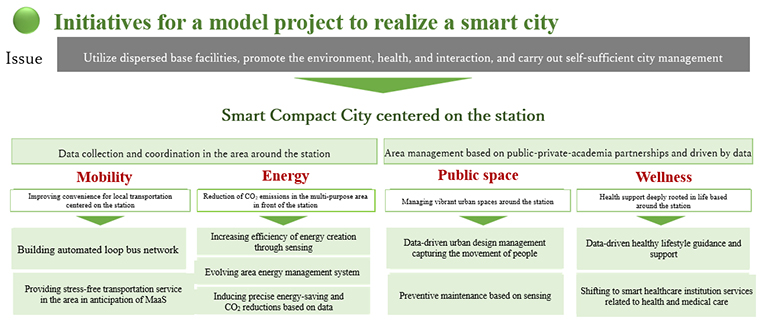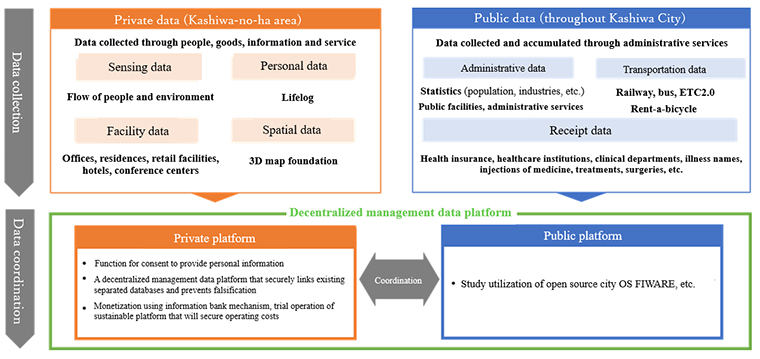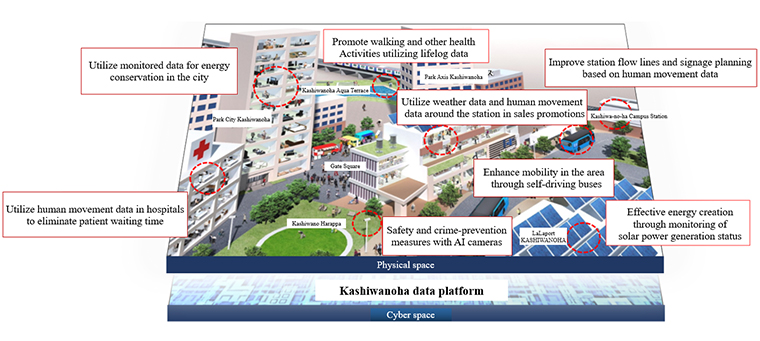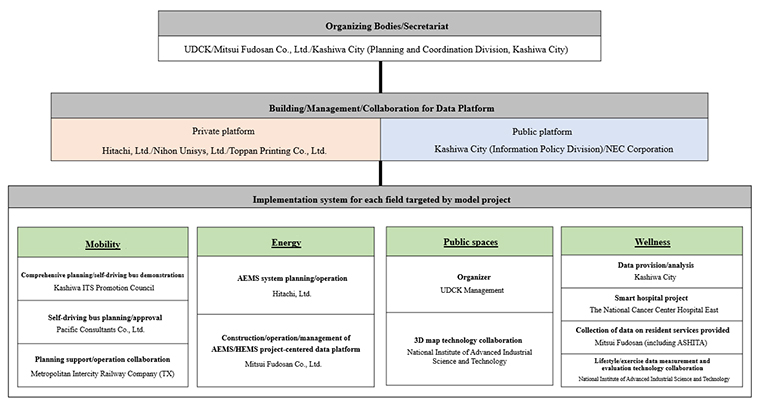Selected by the Ministry of Land, Infrastructure, Transport and Tourism
as a model project for a smart city towards realizing “Society 5.0”
Kashiwa-no-ha Smart City will evolve into a smart, compact city driven by data
Resolving social issues through new technologies such as AI and IoT,
and by utilizing data from both the private and public sectors
Kashiwa City
Mitsui Fudosan Co., Ltd.
Urban Design Center Kashiwa-no-ha [UDCK]
Tokyo, Japan, June 5, 2019 - Mitsui Fudosan Co., Ltd., a leading global real estate company headquartered in Tokyo, announced today that the Kashiwa-no-ha Smart City Consortium, run by Kashiwa City (Mayor: Hiroyasu Akiyama) Mitsui Fudosan Co., Ltd. (President and CEO: Masanobu Komoda), and Urban Design Center Kashiwa-no-ha (President, Atsushi Deguchi), was selected by the Ministry of Land, Infrastructure, Transport and Tourism as an advanced model project for a smart city towards realizing “Society 5.0.”
The Kashiwa-no-ha area, an area with a radius of around one mile (approx. 2 kilometers) centered on Kashiwa-no-ha Campus Station, is home to the base facilities, including the University of Tokyo, Chiba University, and the National Cancer Center Hospital East. In recent years, a number of research institutes have moved to the University of Tokyo Kashiwa II Campus, including the National Institute of Advanced Industrial Science and Technology (AIST). Seeking further urban development, the Kashiwa-no-ha Smart City Consortium will build a data platform linking private-sector and public-sector data, utilizing the special characteristics of the area centered on the station, a place where people, goods, and information tend to congregate. By introducing new technologies such as AI and IoT, the consortium aims to form a data-driven, smart compact city centered on the station.
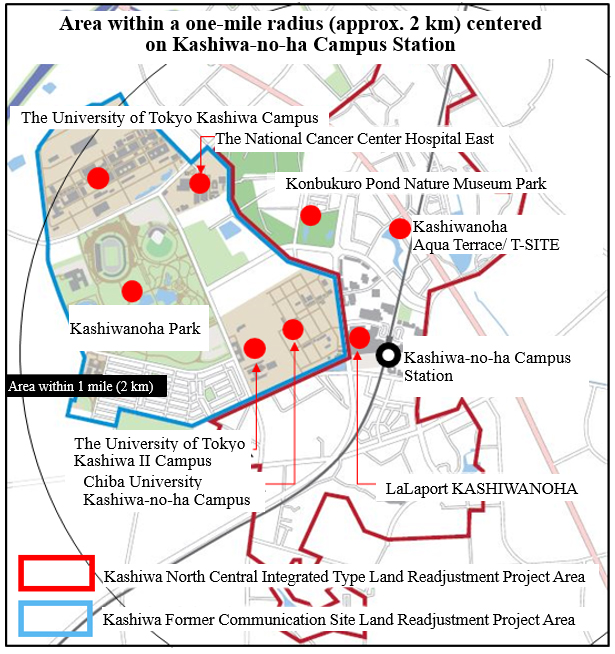
Mobility
- Introduction of self-driving buses (Started pilot operation in FY2019/Full-scale operation in FY2020)
In 2019, a self-driving bus was introduced as a shuttle bus between Kashiwa-no-ha Campus Station and the University of Tokyo Kashiwa Campus (1.6 miles, 2.6 kilometers). Mitsui Fudosan will carry out tests for business feasibility and public reception to move toward the introduction of these buses to regular routes while enhancing the technology through continuous operation. - Visibility and monitoring of transportation in the vicinity of the station (monitoring starts in 2020)
Visibility and monitoring of the traffic situation in the vicinity of the station using ETC2.0 probe data*1 and other transportation databases. With this, the movement of vehicles traveling in the area will be ascertained and used for the development of new mobile services that address the growing demand for transportation due to the accumulation of urban functions.
- 1 ETC2.0 probe data: Vehicle driving history and behavior history data obtained by communication between ETC2.0 compatible on-board equipment and wireless equipment on roads
Energy
- Construction of an energy-related data platform for facilities in the area (scheduled for full-scale operation in FY2021)
Evolve the conventional AEMS system to increase data storage, promote cross-sectoral data utilization by using the cloud, and increase the efficiency of power interchange through data utilization prediction. By partnering with the Kashiwa-no-ha data platform, link to weather data and human movement data in addition to electricity data, and use this data in measures to effectively reduce power consumption and CO2 emissions. - Introduction of system to automatically detect the degradation of solar panels (full-scale operation in FY2020)
Construct an IoT platform to increase the efficiency of solar power generation. Maintain and improve the power generating efficiency of solar power generation facilities by managing the power generation status of each panel and automatically detecting filth and degradation.
Public space
- AI camera/sensor installation and monitoring, data utilization (demonstration starting in FY2019/full-scale operation in FY2020)
With AI cameras installed in facilities, parks, and other places around the station, utilize in public space management, development and marketing based on human movement analysis, information provision about urban congestion, etc., and information provision including watching over children and the elderly. In addition to evaluating the level of comfort of the area using environmental sensing*2, utilize proposals for optimal space design and determine the status of facilities. - Preventive maintenance and management using sensing and AI analysis (demonstration launched in FY2019/full-fledged operation in FY2020)
Use sensing to collect underground surface cavity analysis data and unlevel road data, and centrally visualize it together with sewer pipe and manhole data to diagnose the risk and estimate the cause of road depressions, and then make repairs in advance as a part of preventive maintenance.
- 2 Environmental sensing: Using sensors to obtain data such as humidity, temperature, volatile organic compounds (VOCs), PM2.5, and CO2
Wellness
- Provision of health services and advice utilizing wide-ranging data (full-fledged operation in FY2020)
Making use of the member network of ASHITA, a participation-style health center located in front of the station where people gather and data can be easily collected, efficiently collect data such as activity level and amount of sleep via wearable devices*3 and sheet-type pressure sensors*4, and use this data to provide detailed health services and advice targeting individuals. Take collected nursing care and medical receipt data*5 as well as activity level and sleep amount data, etc. to identify special characteristics on lifestyle habits and illness history that can cause people to need care, and encourage participation in work, volunteer activities and hobby groups that can lengthen healthy lifespans. - Utilize flow data for people visiting hospitals to eliminate patients’ waiting time (full-scale operation in FY2019)
Measure and analyze the movement of patients after arrival at the hospital, identify where stagnation is occurring, and make related improvements. By setting up remote check-in when the outpatient arrives at the station, the patient can effectively use their waiting time in the Kashiwa-no-ha area, and they can be given instructions for commuting to the hospital (parking information, bus information).
- 3 Wearable devices: Refers to devices that are used while worn on the body, and which use sensors to measure variables such as the wearer’s pulse and activity level
- 4 Sheet-type pressure sensor: A sheet-shaped pressure sensor used to measure breathing during sleep and body movements
- 5 Receipt data: Healthcare remuneration statement data that medical institutions bill to insurers (municipalities and health insurance associations, etc.) related to healthcare services received by patients and which are covered by insurance
Data Use Policy
The Kashiwa-no-ha Smart City Consortium links two platforms: a private platform that collects information in the private sector related to people, the environment, and facilities in the Kashiwa-no-ha area, and a public platform that collects data gathered through government services, and builds a system that allows data to be used across the two platforms. By promoting the shift to open data, the public platform will be able to use data in collaboration with private platforms, and will create new applications and services through cross-sectoral data analysis and utilization.
Future development
Going forward, the data obtained in the Kashiwa-no-ha area will be analyzed and utilized in cyberspace through a data platform to resolve social issues, such as providing services such as automated driving, human movement analysis, environmental impact reduction, health activity promotion, increasing power generation efficiency and hospital diagnosis efficiency, to name just a few. In addition, utilizing the results and know-how gained in the demonstration of this model project, we will revitalize the downtown area around Kashiwa Station, and expand to other cities through Mitsui Fudosan’s urban development and the network of Urban Design Centers (UDC)*6.
- 6 Urban Design Center (UDC): A platform for collaboration between the public sector, private sector, and academic institutions to resolve issues and realize urban development for future creation, as conceptualized when the Urban Design Center Kashiwa-no-ha (UDCK) was founded in 2006. Going beyond the framework for administrative city planning and citizen-based urban development, an Urban Design Center serves as a new form of an urban development organization and as a base for various bodies in the community to work together, and for urban design specialists to be involved from an objective position. As of May 2019, there are 19 Urban Design Centers throughout Japan.
Kashiwa-no-ha Smart City consortium system
UDCK, Mitsui Fudosan, and Kashiwa City, which have been engaged in urban development based on a public-private- academia partnership, oversee the program. In the construction and operation of the data platforms and model business, overall planning and construction are primarily handled by leading Japanese companies in each field, while demonstrations and implementation are handled by companies with track records in the local area as well as UDCK Town Management. In this way, the system allows national and local players to work together in a balanced manner.
Kashiwa City (URL: http://www.city.kashiwa.lg.jp/ )
Kashiwa City is a core city located in the northwestern part of Chiba Prefecture with a population of about 420,000 people. A variety of institutions and facilities run by the national government and the prefecture are located in the Kashiwa-no-ha area, including the University of Tokyo Kashiwa Campus, Chiba University’s Center for Environment, Health and Field Sciences, the National Institute of Advanced Industrial Science and Technology Kashiwa Center, and Tokatsu Techno Plaza.
Mitsui Fudosan Co., Ltd.(URL: https://www.mitsuifudosan.co.jp/ )
Mitsui Fudosan seeks to create new industries by leveraging a wide range of business domains and its business network both in Japan and overseas. Aiming to create an urban development model to solve global issues, in the area around Kashiwa-no-ha Campus Station in Kashiwa City, Chiba Prefecture, Mitsui Fudosan is advancing the Kashiwa-no-ha Smart City Project, which is based on the three themes of an environmental-symbiotic city, health and longevity, and the creation of new industries.
Urban Design Center Kashiwa-no-ha [UDCK] (URL:http://www.udck.jp/ )
UDCK was established in 2006 as an urban design base jointly run by seven bodies: University of Tokyo, Chiba University, Kashiwa City, Mitsui Fudosan, Kashiwa Chamber of Commerce and Industry, Tanaka Region Hometown Council, and Metropolitan Intercity Railway Company. Based in the Kashiwa-no-ha district of Kashiwa City, Chiba Prefecture, UDCK promotes international academic research cities and the development of next-generation environmental cities through collaborations between public, private, and academic entities, and supports urban planning research, social experiments, and citizen activities, as well as disseminates information to the public.



























